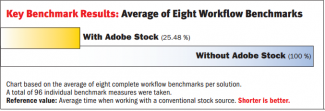Adobe is putting a shine on its Creative Cloud video production suite ahead of the IBC 2016 trade show, showcasing a number of features such as a 3D rendering engine and HDR10 metadata support in a pre-show media presentation. But the company put particular emphasis on its stock video library, publishing a Pfeiffer Consulting-conducted study that touted a “6x productivity” gain over other stock video providers when working with such content.
In short, Adobe suggested that its stock video is better than “their” stock video.
Why the sudden emphasis on Creative Cloud’s stock footage? Basically, a number of upstart stock video providers like Pond5 and Videoblocks have been making rapid gains in what was a fairly quiet market segment for a number of years.
Videoblocks, for example, offers a two-sided business model – members can, for a flat monthly fee, access its own library of video content; they also can buy more content directly from stock video creators in Videoblocks’ Marketplace. Similarly, Pond5 offers flat rate subscription tiers that allow a certain number of stock video downloads each month.
While the Adobe-Pfeiffer study didn’t mention these services by name, it did cite the aforementioned “efficiency gains” when working with Adobe Stock versus “web-based stock libraries.”
“Adobe Stock differs from most stock image services through the tight integration it offers with Creative Cloud applications such as Adobe Premiere Pro CC, Adobe Photoshop CC, Adobe After Effects CC and more: watermarked stock footage can be sent directly from the Adobe Stock website to Premiere Pro CC, where it will be imported automatically,” the study said.
Pfeiffer said it conducted a productivity benchmarking study that looks at the time it takes “experienced operators” to do certain tasks. The research firm set eight workflow benchmarks, using Adobe Stock in combination with Adobe Premiere Pro CC, and used HD and 4K stock footage in two different workflow situations (importing and then licensing the clip, versus placing and licensing an integrated clip). The firm took 96 individual benchmarking measures and averaged them across the eight set benchmarks.

Using Adobe Stock knocked several steps out of the video clip placement process, according to the study, diminishing the time it took to fully place a clip into a longer video from just under four minutes to less than a minute. Pfeiffer said the integrated clips increased productivity by six times.
Pretty amazing, no? Stay with me here. Granted, this study was conducted on Adobe’s behalf with the express purpose of showing how much better stock video works when it’s part of an integrated video production system like Creative Cloud.
But the fact the Adobe spent the money to conduct this study is what’s really interesting here. It’s just stock footage. But the effort Adobe is making to lure and keep video editors within its Creative Cloud fold, using its stock library, suggests that stock video is becoming a much more lucrative market segment.
It also suggests that Adobe is taking an anxious look in the rear-view mirror, as those nefarious “web-based” stock video providers begin to draw in more profits. Videoblocks said in January that it has more than 130,000 subscribers – but more interestingly, in the fourth quarter of 2015 it signed up 50 percent more subs than it had ever done in its six years of existence, suggesting much faster growth for the company.
For more:
- see the release
- see the study (PDF)
Related articles:
Pond5 boosts search and discovery as competition amps up in the stock video space
VideoBlocks takes on Shutterstock with enterprise video footage launch